Long-Term Spatiotemporal Trends in Precipitation, Temperature, and Evapotranspiration Across Arid Asia and Africa
Abstract
:1. Introduction
2. Study Area and Data
2.1. Study Area
2.2. Data Sources
3. Research Methods
3.1. Basic Statistics
3.2. Modified Mann-Kendall (MMK) Test
3.3. Change Point Analysis
3.4. Kriging Interpolation Method
4. Results and Discussion
4.1. Temporal Analysis of Climatic Parameters
4.1.1. General Descriptive Statistics
4.1.2. Trend Analysis of the Climatic Parameters
4.2. Spatial Characteristics of Climatic Parameters
4.2.1. Spatial Variation in the Climatic Parameters
4.2.2. Spatial Trend Analysis of the Climatic Elements
5. Limitations and Future Research Directions
6. Conclusions
Supplementary Materials
Author Contributions
Funding
Data Availability Statement
Conflicts of Interest
References
- Elizbarashvili, M.; Elizbarashvili, E.; Tatishvili, M.; Elizbarashvili, S.; Meskhia, R.; Kutaladze, N.; King, L.; Keggenhoff, I.; Khardziani, T. Georgian climate change under global warming conditions. Ann. Agrar. Sci. 2017, 15, 17–25. [Google Scholar] [CrossRef]
- Adeyeri, O.E.; Laux, P.; Ishola, K.A.; Zhou, W.; Balogun, I.A.; Adeyewa, Z.D.; Kunstmann, H. Homogenising meteorological variables: Impact on trends and associated climate indices. J. Hydrol. 2022, 607, 127585. [Google Scholar] [CrossRef]
- Donat, M.G.; Peterson, T.C.; Brunet, M.; King, A.D.; Almazroui, M.; Kolli, R.K.; Boucherf, D.; Al-Mulla, A.Y.; Nour, A.Y.; Aly, A.A.; et al. Changes in extreme temperature and precipitation in the Arab region: Long-term trends and variability related to ENSO and NAO. Int. J. Climatol. 2014, 34, 581–592. [Google Scholar] [CrossRef]
- Ongoma, V.; Chen, H. Temporal and spatial variability of temperature and precipitation over East Africa from 1951 to 2010. Meteorol. Atmos. Phys. 2017, 129, 131–144. [Google Scholar] [CrossRef]
- Adeyeri, O.E.; Zhou, W.; Wang, X.; Zhang, R.; Laux, P.; Ishola, K.A.; Usman, M. The trend and spatial spread of multisectoral climate extremes in CMIP6 models. Sci. Rep. 2022, 12, 21000. [Google Scholar] [CrossRef]
- Liuzzo, L.; Bono, E.; Sammartano, V.; Freni, G. Analysis of spatial and temporal rainfall trends in Sicily during the 1921–2012 period. Theor. Appl. Climatol. 2016, 126, 113–129. [Google Scholar] [CrossRef]
- Revesz, R.L.; Howard, P.H.; Arrow, K.; Goulder, L.H.; Kopp, R.E.; Livermore, M.A.; Oppenheimer, M.; Sterner, T. Global warming: Improve economic models of climate change. Nature 2014, 508, 173–175. [Google Scholar] [CrossRef]
- Wheeler, T.; Braun, J. von. Climate change impacts on global food security. Science 2013, 341, 508–513. [Google Scholar] [CrossRef] [PubMed]
- Adeyeri, O.E.; Zhou, W.; Ndehedehe, C.E.; Wang, X.; Ishola, K.A.; Laux, P. Minimizing uncertainties in climate projections and water budget reveals the vulnerability of freshwater to climate change. One Earth 2024, 7, 72–87. [Google Scholar] [CrossRef]
- Adeyeri, O.E.; Zhou, W.; Laux, P.; Ndehedehe, C.E.; Wang, X.; Usman, M.; Akinsanola, A.A. Multivariate Drought Monitoring, Propagation, and Projection Using Bias-Corrected General Circulation Models. Earth’s Future 2023, 11. [Google Scholar] [CrossRef]
- Huang, J.; Li, Y.; Fu, C.; Chen, F.; Fu, Q.; Dai, A.; Shinoda, M.; Ma, Z.; Guo, W.; Li, Z.; et al. Dryland climate change: Recent progress and challenges. Rev. Geophys. 2017, 55, 719–778. [Google Scholar] [CrossRef]
- Trenberth, K.E.; Fasullo, J.T.; Shepherd, T.G. Attribution of climate extreme events. Nat. Clim Chang. 2015, 5, 725–730. [Google Scholar] [CrossRef]
- Oswald, J.; Harris, S. Desertification. Biological and Environmental Hazards, Risks, and Disasters; Elsevier: Amsterdam, The Netherlands, 2023; pp. 369–393. ISBN 9780128205099. [Google Scholar]
- Zittis, G.; Hadjinicolaou, P.; Klangidou, M.; Proestos, Y.; Lelieveld, J. A multi-model, multi-scenario, and multi-domain analysis of regional climate projections for the Mediterranean. Reg. Environ. Chang. 2019, 19, 2621–2635. [Google Scholar] [CrossRef]
- Karzani, M.; Ghavidel, Y.; Farajzadeh, M. Temporal Changes in Lethal Temperatures Above 50 °C in the Northern Hemisphere. Pure Appl. Geophys. 2022, 179, 3377–3390. [Google Scholar] [CrossRef]
- Zittis, G.; Hadjinicolaou, P.; Almazroui, M.; Bucchignani, E.; Driouech, F.; El Rhaz, K.; Kurnaz, L.; Nikulin, G.; Ntoumos, A.; Ozturk, T.; et al. Business-as-usual will lead to super and ultra-extreme heatwaves in the Middle East and North Africa. NPJ Clim. Atmos. Sci. 2021, 4, 20. [Google Scholar] [CrossRef]
- Goyal, M.K.; Singh, S.; Jain, V. Heat waves characteristics intensification across Indian smart cities. Sci. Rep. 2023, 13, 14786. [Google Scholar] [CrossRef]
- Almazroui, M.; Saeed, S.; Saeed, F.; Islam, M.N.; Ismail, M. Projections of Precipitation and Temperature over the South Asian Countries in CMIP6. Earth Syst. Environ. 2020, 4, 297–320. [Google Scholar] [CrossRef]
- Feulner, G.R. Geography and Geology of the United Arab Emirates: A Naturalist’s Introduction. In A Natural History of the Emirates; Burt, J.A., Ed.; Springer Nature: Cham, Switzerland, 2024; pp. 13–64. ISBN 978-3-031-37396-1. [Google Scholar]
- Middleton, N.J.; Thomas, D. World Atlas of Desertification, 2nd ed.; United Nations Environment Programme (UNEP); Arnold: London, UK, 1997. [Google Scholar]
- Gardner, J. How water, wind, waves and ice shape landscapes and landforms: Historical contributions to geomorphic science. Geomorphology 2020, 366, 106687. [Google Scholar] [CrossRef]
- Engelstaedter, S.; Kohfeld, K.E.; Tegen, I.; Harrison, S.P. Controls of dust emissions by vegetation and topographic depressions: An evaluation using dust storm frequency data. Geophys. Res. Lett. 2003, 30, 1294. [Google Scholar] [CrossRef]
- Hamed, K.H.; Ramachandra Rao, A. A modified Mann-Kendall trend test for autocorrelated data. J. Hydrol. 1998, 204, 182–196. [Google Scholar] [CrossRef]
- Tabari, H.; Willems, P. More prolonged droughts by the end of the century in the Middle East. Environ. Res. Lett. 2018, 13, 104005. [Google Scholar] [CrossRef]
- Nicholson, S.E. Dryland Climatology; Cambridge University Press: Cambridge, UK, 2011; ISBN 9780521516495. [Google Scholar]
- Trenberth, K.E. Changes in precipitation with climate change. Clim. Res. 2011, 47, 123–138. [Google Scholar] [CrossRef]
- Mariotti, A.; Pan, Y.; Zeng, N.; Alessandri, A. Long-term climate change in the Mediterranean region in the midst of decadal variability. Clim. Dyn. 2015, 44, 1437–1456. [Google Scholar] [CrossRef]
- Vicente-Serrano, S.M.; McVicar, T.R.; Miralles, D.G.; Yang, Y.; Tomas-Burguera, M. Unraveling the influence of atmospheric evaporative demand on drought and its response to climate change. WIREs Clim. Chang. 2020, 11, e632. [Google Scholar] [CrossRef]
- Adeyeri, O.E.; Zhou, W.; Ndehedehe, C.E.; Wang, X. Global vegetation, moisture, thermal and climate interactions intensify compound extreme events. Sci. Total Environ. 2024, 912, 169261. [Google Scholar] [CrossRef] [PubMed]
- Hoerling, M.; Eischeid, J.; Perlwitz, J.; Quan, X.; Zhang, T.; Pegion, P. On the Increased Frequency of Mediterranean Drought. J. Clim. 2012, 25, 2146–2161. [Google Scholar] [CrossRef]
- He, J.; Deser, C.; Soden, B.J. Atmospheric and Oceanic Origins of Tropical Precipitation Variability. J. Clim. 2017, 30, 3197–3217. [Google Scholar] [CrossRef]
- Zhang, R.; Tian, W.; He, X.; Qie, K.; Liu, D.; Tian, H. Enhanced influence of ENSO on winter precipitation over southern China in recent decades. J. Clim. 2021, 34, 7983–7994. [Google Scholar] [CrossRef]
- IPCC. Climate Change 2021: The Physical Science Basis. Contribution of Working Group I to the Sixth Assessment Report of the Intergovernmental Panel on Climate Change; The Intergovernmental Panel on Climate Change; Cambridge University Press: Cambridge, UK, 2021. [Google Scholar]
- Lelieveld, J.; Proestos, Y.; Hadjinicolaou, P.; Tanarhte, M.; Tyrlis, E.; Zittis, G. Strongly increasing heat extremes in the Middle East and North Africa (MENA) in the 21st century. Clim. Chang. 2016, 137, 245–260. [Google Scholar] [CrossRef]
- Sherwood, S.; Fu, Q. Climate change. A drier future? Science 2014, 343, 737–739. [Google Scholar] [CrossRef]
- Sonali, P.; Nagesh Kumar, D. Spatio-temporal variability of temperature and potential evapotranspiration over India. J. Water Clim. Chang. 2016, 7, 810–822. [Google Scholar] [CrossRef]
- Hu, Z.; Chen, X.; Chen, D.; Li, J.; Wang, S.; Zhou, Q.; Yin, G.; Guo, M. “Dry gets drier, wet gets wetter”: A case study over the arid regions of central Asia. Int. J. Climatol. 2019, 39, 1072–1091. [Google Scholar] [CrossRef]
- Mueller, B.; Seneviratne, S.I. Systematic land climate and evapotranspiration biases in CMIP5 simulations. Geophys. Res. Lett. 2014, 41, 128–134. [Google Scholar] [CrossRef] [PubMed]
- Huang, J.; Ji, M.; Xie, Y.; Wang, S.; He, Y.; Ran, J. Global semi-arid climate change over last 60 years. Clim Dyn 2016, 46, 1131–1150. [Google Scholar] [CrossRef]
- Schurer, A.P.; Hegerl, G.C.; Goosse, H.; Bollasina, M.A.; England, M.H.; Smith, D.M.; Tett, S.F.B. Role of multi-decadal variability of the winter North Atlantic Oscillation on Northern Hemisphere climate. Environ. Res. Lett. 2023, 18, 44046. [Google Scholar] [CrossRef]
- Cai, W.; Santoso, A.; Wang, G.; Yeh, S.-W.; An, S.-I.; Cobb, K.M.; Collins, M.; Guilyardi, E.; Jin, F.-F.; Kug, J.-S.; et al. ENSO and greenhouse warming. Nat. Clim. Chang. 2015, 5, 849–859. [Google Scholar] [CrossRef]
- Sowers, J.; Vengosh, A.; Weinthal, E. Climate change, water resources, and the politics of adaptation in the Middle East and North Africa. Clim. Chang. 2011, 104, 599–627. [Google Scholar] [CrossRef]
- Kelley, C.P.; Mohtadi, S.; Cane, M.A.; Seager, R.; Kushnir, Y. Climate change in the Fertile Crescent and implications of the recent Syrian drought. Proc. Natl. Acad. Sci. USA 2015, 112, 3241–3246. [Google Scholar] [CrossRef]
- Lobell, D.B.; Schlenker, W.; Costa-Roberts, J. Climate trends and global crop production since 1980. Science 2011, 333, 616–620. [Google Scholar] [CrossRef]
- Davy, R.; Esau, I.; Chernokulsky, A.; Outten, S.; Zilitinkevich, S. Diurnal asymmetry to the observed global warming. Int. J. Climatol. 2017, 37, 79–93. [Google Scholar] [CrossRef]
- Vicente-Serrano, S.M.; Lopez-Moreno, J.-I.; Beguería, S.; Lorenzo-Lacruz, J.; Sanchez-Lorenzo, A.; García-Ruiz, J.M.; Azorin-Molina, C.; Morán-Tejeda, E.; Revuelto, J.; Trigo, R.; et al. Evidence of increasing drought severity caused by temperature rise in southern Europe. Environ. Res. Lett. 2014, 9, 44001. [Google Scholar] [CrossRef]
- Turco, M.; von Hardenberg, J.; AghaKouchak, A.; Llasat, M.C.; Provenzale, A.; Trigo, R.M. On the key role of droughts in the dynamics of summer fires in Mediterranean Europe. Sci. Rep. 2017, 7, 81. [Google Scholar] [CrossRef] [PubMed]
- Fu, Q.; Feng, S. Responses of terrestrial aridity to global warming. J. Geophys. Res. Atmos. 2014, 119, 7863–7875. [Google Scholar] [CrossRef]
- Francis, D.; Fonseca, R. Recent and projected changes in climate patterns in the Middle East and North Africa (MENA) region. Sci. Rep. 2024, 14, 10279. [Google Scholar] [CrossRef] [PubMed]
- Lelieveld, J.; Hadjinicolaou, P.; Kostopoulou, E.; Chenoweth, J.; El Maayar, M.; Giannakopoulos, C.; Hannides, C.; Lange, M.A.; Tanarhte, M.; Tyrlis, E.; et al. Climate change and impacts in the Eastern Mediterranean and the Middle East. Clim. Chang. 2012, 114, 667–687. [Google Scholar] [CrossRef]
- Luo, M.; Liu, T.; Meng, F.; Duan, Y.; Bao, A.; Frankl, A.; de Maeyer, P. Spatiotemporal characteristics of future changes in precipitation and temperature in Central Asia. Int. J. Climatol. 2019, 39, 1571–1588. [Google Scholar] [CrossRef]
- Huang, J.; Yu, H.; Guan, X.; Wang, G.; Guo, R. Accelerated dryland expansion under climate change. Nat. Clim. Chang. 2016, 6, 166–171. [Google Scholar] [CrossRef]
- Loarie, S.R.; Duffy, P.B.; Hamilton, H.; Asner, G.P.; Field, C.B.; Ackerly, D.D. The velocity of climate change. Nature 2009, 462, 1052–1055. [Google Scholar] [CrossRef]
- Schlaepfer, D.R.; Bradford, J.B.; Lauenroth, W.K.; Munson, S.M.; Tietjen, B.; Hall, S.A.; Wilson, S.D.; Duniway, M.C.; Jia, G.; Pyke, D.A.; et al. Climate change reduces extent of temperate drylands and intensifies drought in deep soils. Nat. Commun. 2017, 8, 14196. [Google Scholar] [CrossRef]
- Vose, R.S.; Easterling, D.R.; Gleason, B. Maximum and minimum temperature trends for the globe: An update through 2004. Geophys. Res. Lett. 2005, 32, L23822. [Google Scholar] [CrossRef]
- Diffenbaugh, N.S.; Scherer, M. Observational and model evidence of global emergence of permanent, unprecedented heat in the 20(th) and 21(st) centuries. Clim. Chang. 2011, 107, 615–624. [Google Scholar] [CrossRef] [PubMed]
- Barnett, T.P.; Adam, J.C.; Lettenmaier, D.P. Potential impacts of a warming climate on water availability in snow-dominated regions. Nature 2005, 438, 303–309. [Google Scholar] [CrossRef] [PubMed]
- Adeyeri, O.E.; Folorunsho, A.H.; Ayegbusi, K.I.; Bobde, V.; Adeliyi, T.E.; Ndehedehe, C.E.; Akinsanola, A.A. Land surface dynamics and meteorological forcings modulate land surface temperature characteristics. Sustain. Cities Soc. 2024, 101, 105072. [Google Scholar] [CrossRef]
- McVicar, T.R.; Roderick, M.L.; Donohue, R.J.; Li, L.T.; van Niel, T.G.; Thomas, A.; Grieser, J.; Jhajharia, D.; Himri, Y.; Mahowald, N.M.; et al. Global review and synthesis of trends in observed terrestrial near-surface wind speeds: Implications for evaporation. J. Hydrol. 2012, 416–417, 182–205. [Google Scholar] [CrossRef]
- Zhang, Y.; Peña-Arancibia, J.L.; McVicar, T.R.; Chiew, F.H.S.; Vaze, J.; Liu, C.; Lu, X.; Zheng, H.; Wang, Y.; Liu, Y.Y.; et al. Multi-decadal trends in global terrestrial evapotranspiration and its components. Sci. Rep. 2016, 6, 19124. [Google Scholar] [CrossRef] [PubMed]
- Feng, S.; Fu, Q. Expansion of global drylands under a warming climate. Atmos. Chem. Phys. 2013, 13, 10081–10094. [Google Scholar] [CrossRef]
- Tramblay, Y.; Koutroulis, A.; Samaniego, L.; Vicente-Serrano, S.M.; Volaire, F.; Boone, A.; Le Page, M.; Llasat, M.C.; Albergel, C.; Burak, S.; et al. Challenges for drought assessment in the Mediterranean region under future climate scenarios. Earth-Sci. Rev. 2020, 210, 103348. [Google Scholar] [CrossRef]
- Lüdecke, H.-J.; Müller-Plath, G.; Wallace, M.G.; Lüning, S. Decadal and multidecadal natural variability of African rainfall. J. Hydrol. Reg. Stud. 2021, 34, 100795. [Google Scholar] [CrossRef]
- Knippertz, P.; Christoph, M.; Speth, P. Long-term precipitation variability in Morocco and the link to the large-scale circulation in recent and future climates. Meteorol. Atmos. Phys. 2003, 83, 67–88. [Google Scholar] [CrossRef]
- Hoell, A.; Funk, C.; Zinke, J.; Harrison, L. Modulation of the Southern Africa precipitation response to the El Niño Southern Oscillation by the subtropical Indian Ocean Dipole. Clim. Dyn. 2017, 48, 2529–2540. [Google Scholar] [CrossRef]
- Zittis, G. Observed rainfall trends and precipitation uncertainty in the vicinity of the Mediterranean, Middle East and North Africa. Theor. Appl. Climatol. 2018, 134, 1207–1230. [Google Scholar] [CrossRef]
- Dardel, C.; Kergoat, L.; Hiernaux, P.; Mougin, E.; Grippa, M.; Tucker, C.J. Re-greening Sahel: 30years of remote sensing data and field observations (Mali, Niger). Remote Sens. Environ. 2014, 140, 350–364. [Google Scholar] [CrossRef]
- Zhang, R.; Delworth, T.L. Impact of Atlantic multidecadal oscillations on India/Sahel rainfall and Atlantic hurricanes. Geophys. Res. Lett. 2006, 33, L17712. [Google Scholar] [CrossRef]
- Pal, J.S.; Eltahir, E.A.B. Future temperature in southwest Asia projected to exceed a threshold for human adaptability. Nature Clim. Chang. 2016, 6, 197–200. [Google Scholar] [CrossRef]
- Allen, R.G. Crop Evapotranspiration: Guidelines for Computing Crop Water Requirements; Food and Agriculture Organization of the United Nations: Rome, Italy, 1998; ISBN 9251042195. [Google Scholar]
- Voss, K.A.; Famiglietti, J.S.; Lo, M.; Linage, C.; Rodell, M.; Swenson, S.C. Groundwater depletion in the Middle East from GRACE with implications for transboundary water management in the Tigris-Euphrates-Western Iran region. Water Resour. Res. 2013, 49, 904–914. [Google Scholar] [CrossRef] [PubMed]
- Stott, P.A.; Christidis, N.; Otto, F.E.L.; Sun, Y.; Vanderlinden, J.-P.; van Oldenborgh, G.J.; Vautard, R.; von Storch, H.; Walton, P.; Yiou, P.; et al. Attribution of extreme weather and climate-related events. Wiley Interdiscip. Rev. Clim. Chang. 2016, 7, 23–41. [Google Scholar] [CrossRef]
- Giorgi, F.; Lionello, P. Climate change projections for the Mediterranean region. Glob. Planet. Chang. 2008, 63, 90–104. [Google Scholar] [CrossRef]
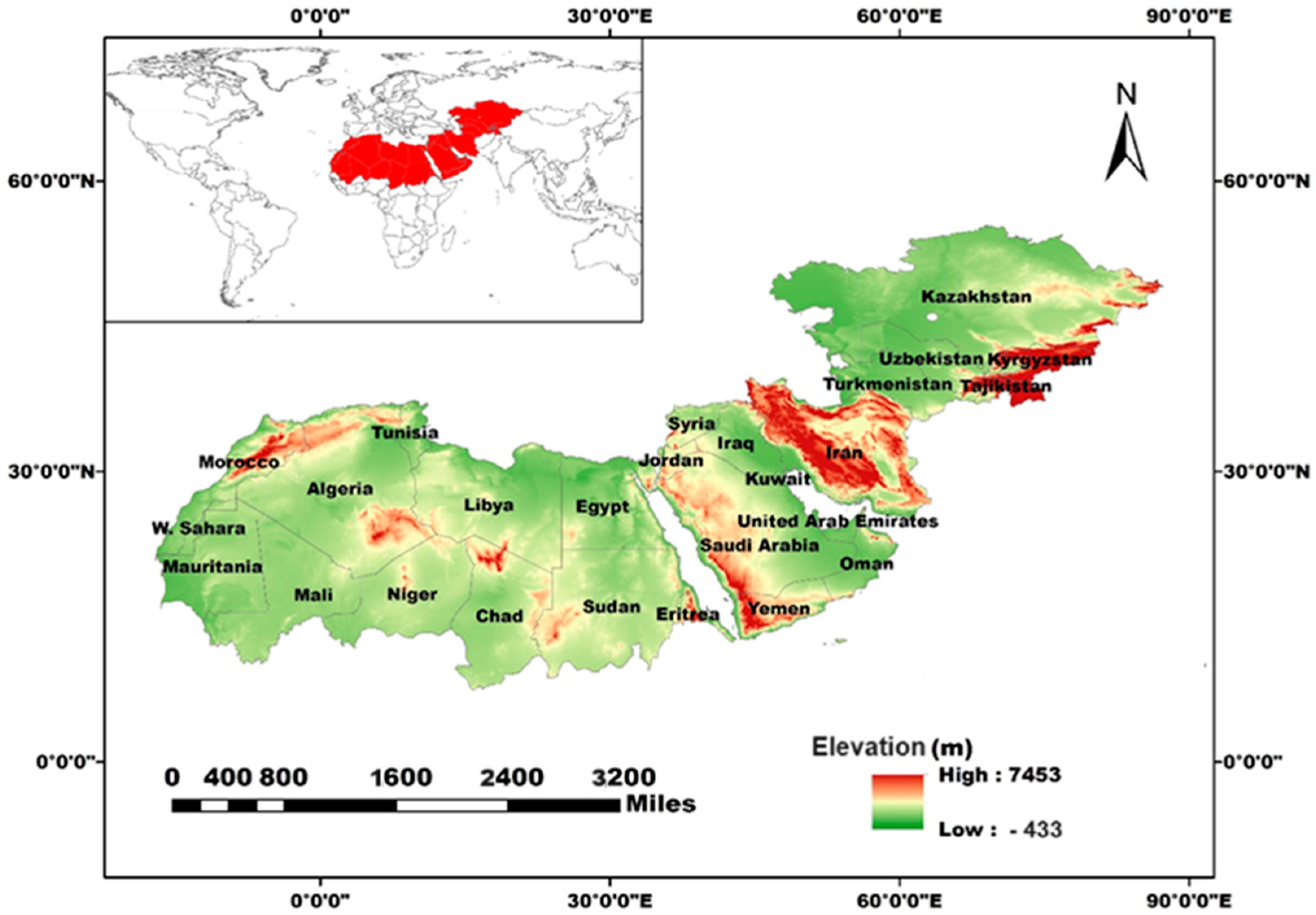




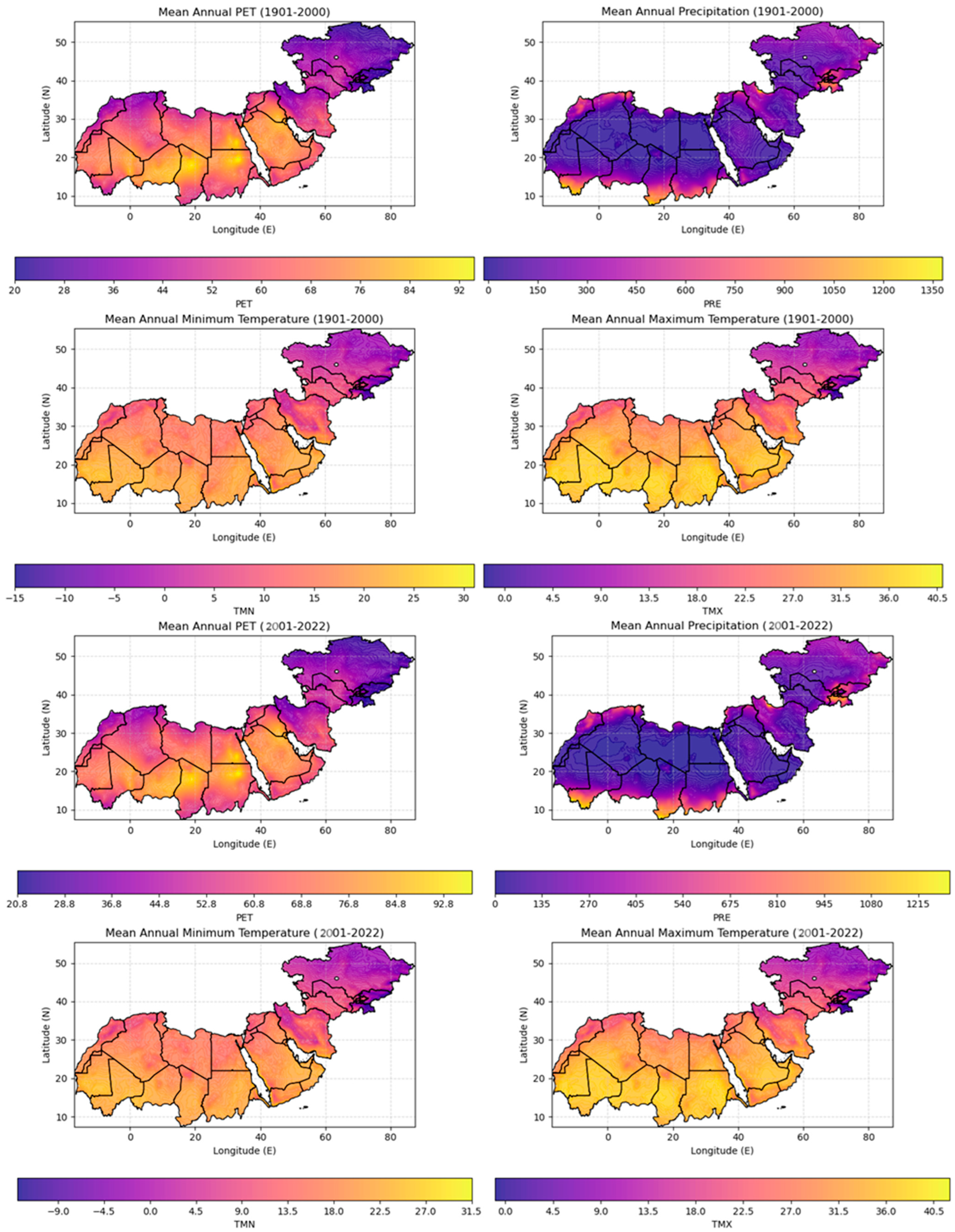

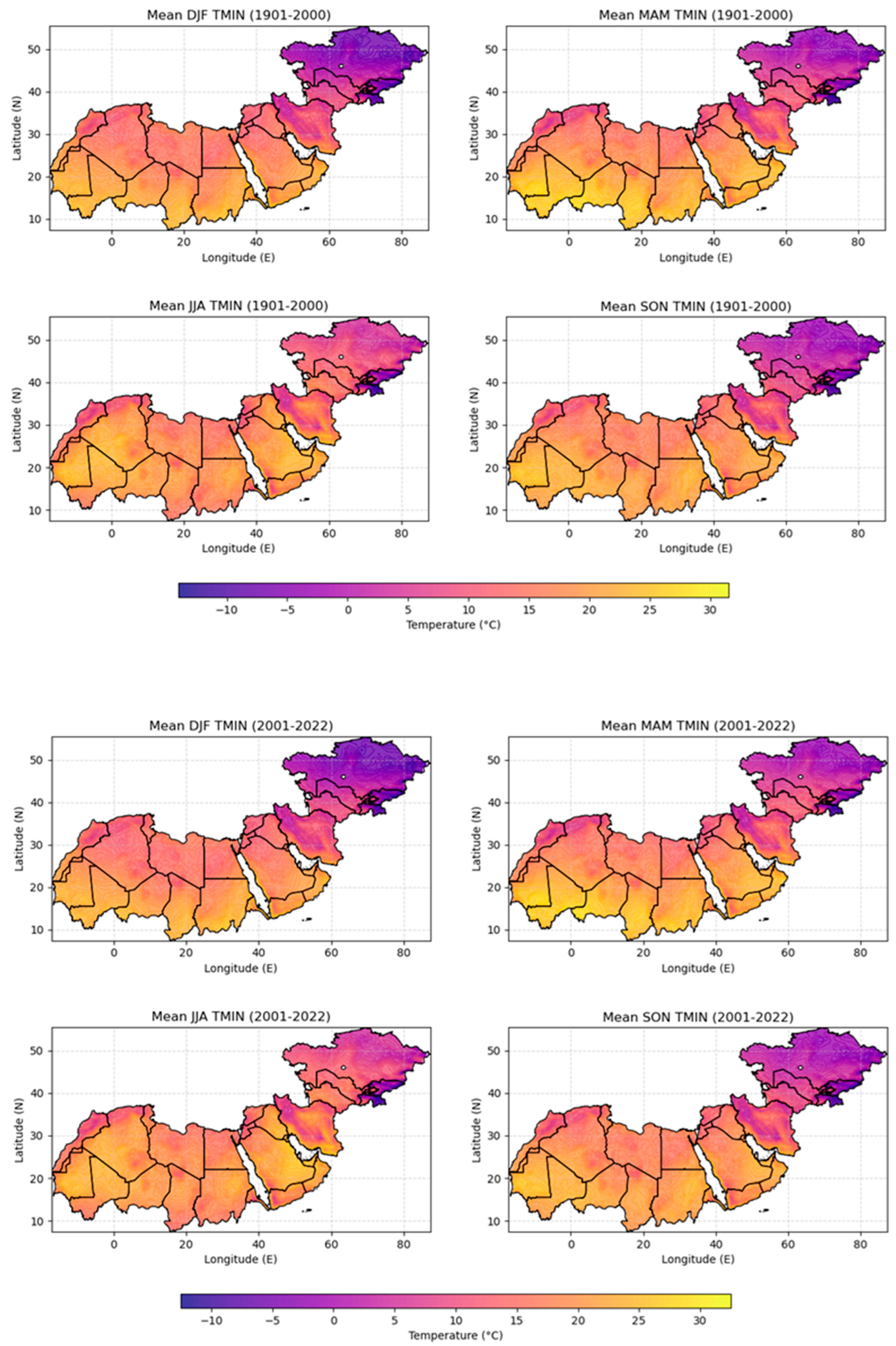
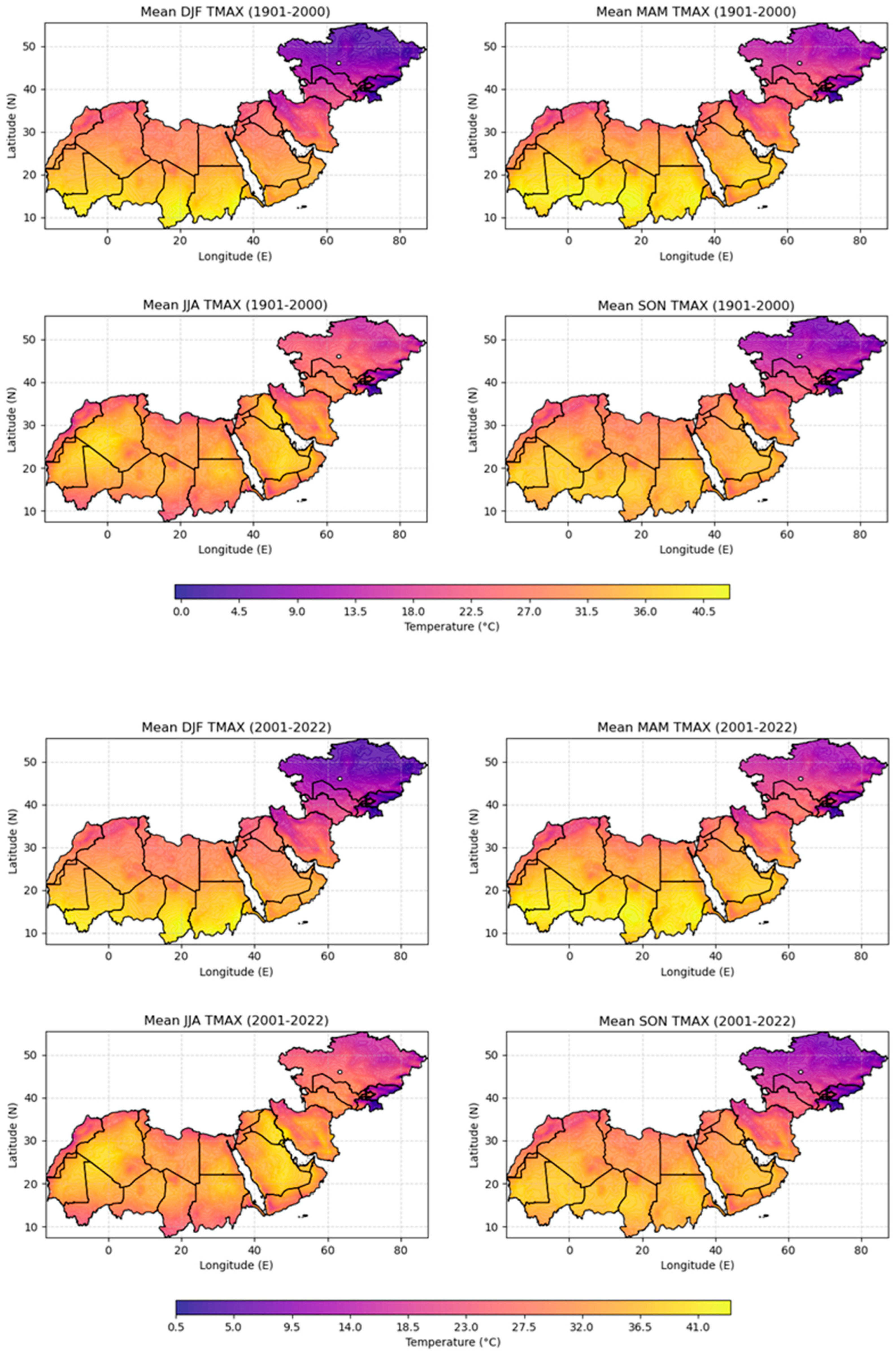
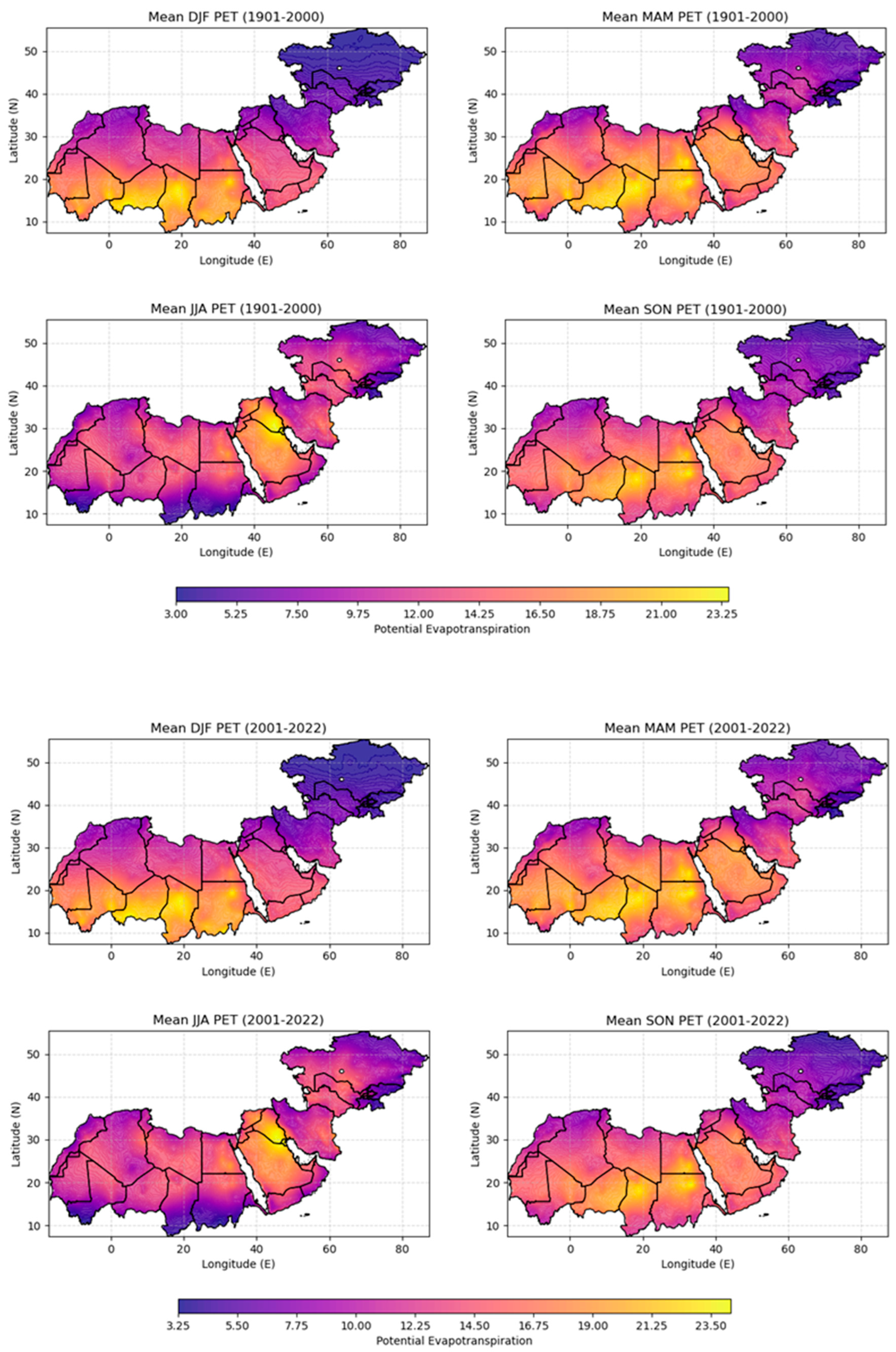

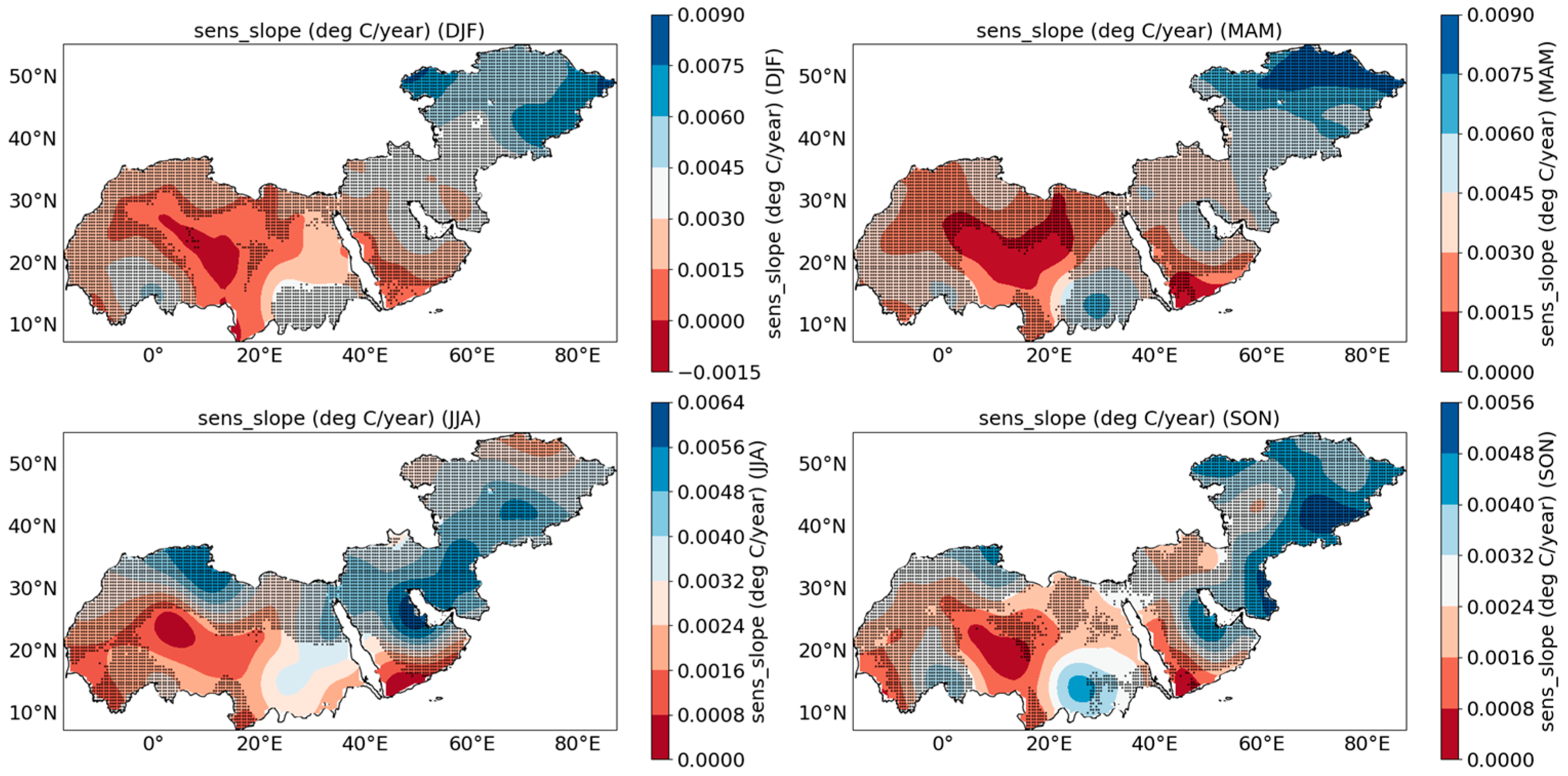

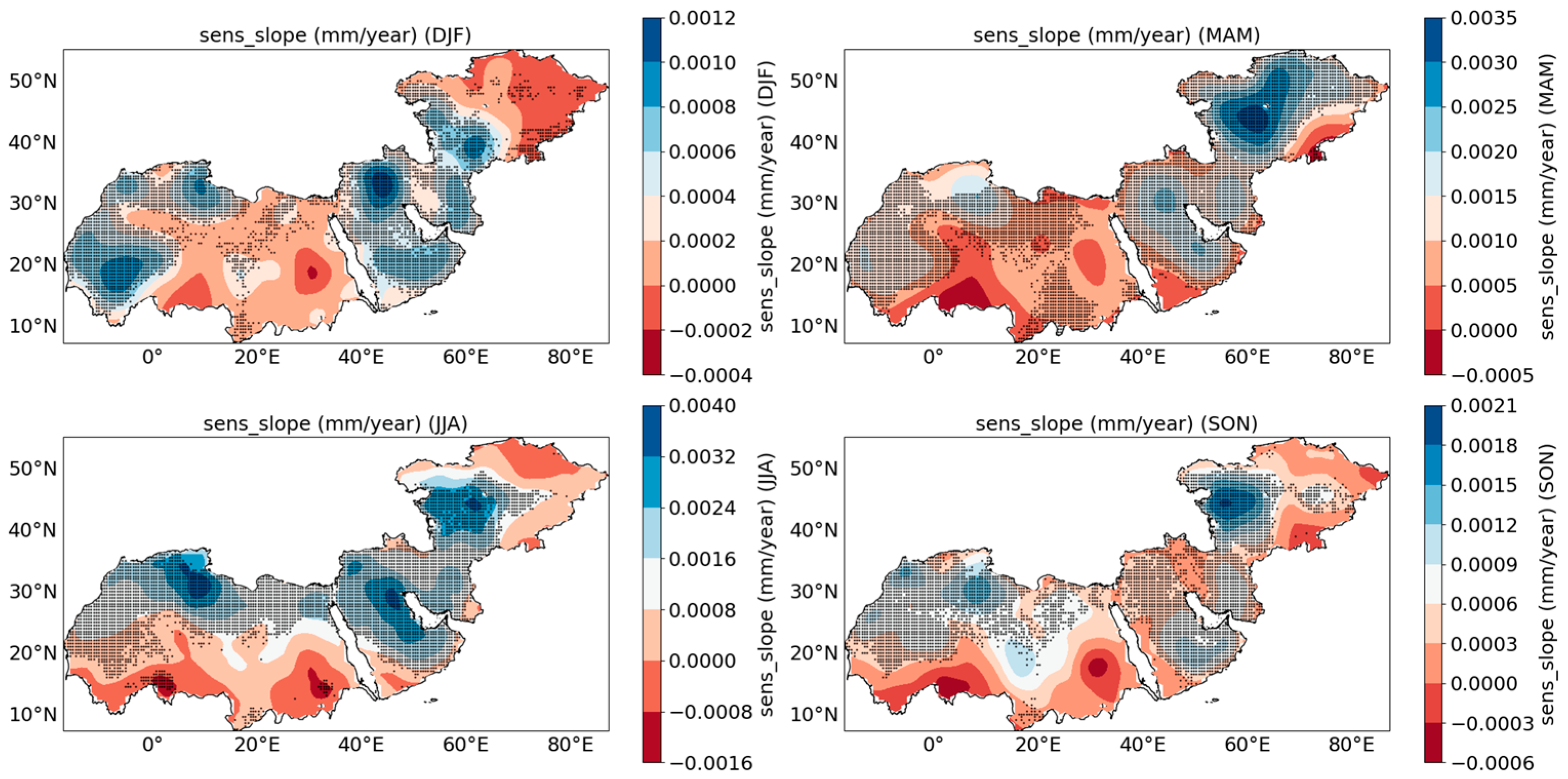
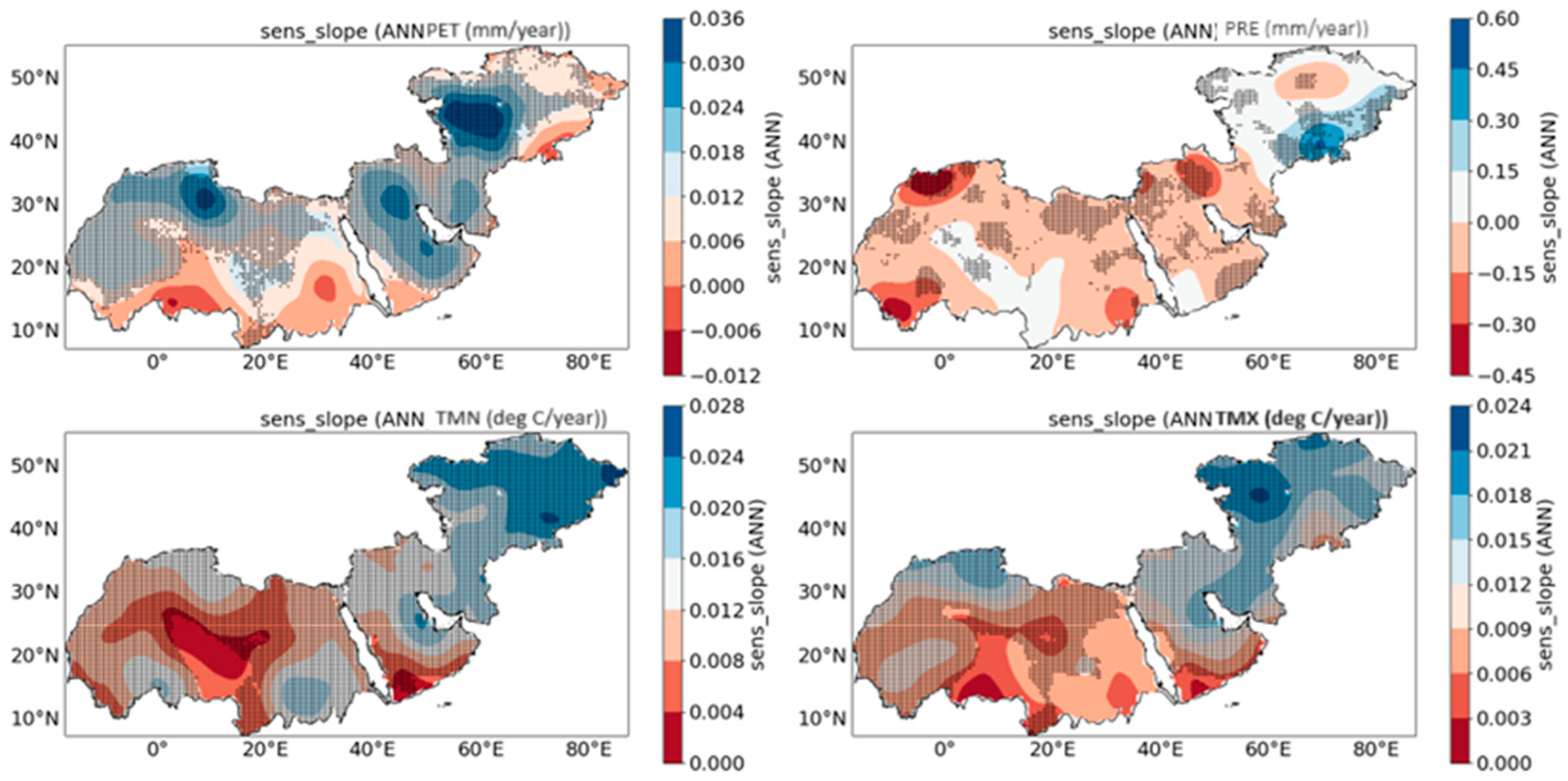
| Seasons | First Year | Last Year | No of Years | Z-Statistic | p-Value | Kendall Tau | Sen’s Slope |
|---|---|---|---|---|---|---|---|
| DJF | 1901 | 1950 | 50 | −0.017 | 0.987 | −0.002 | −0.001 |
| 1951 | 2000 | 50 | 0.318 | 0.751 | 0.032 | 0.019 | |
| 2001 | 2022 | 22 | −1.974 | 0.048 | −0.307 | −0.378 | |
| 1901 | 2022 | 122 | −0.381 | 0.703 | −0.023 | −0.006 | |
| MAM | 1901 | 1950 | 50 | −0.770 | 0.442 | −0.076 | −0.030 |
| 1951 | 2000 | 50 | −1.138 | 0.255 | −0.112 | −0.069 | |
| 2001 | 2022 | 22 | 0.000 | 1.000 | −0.004 | −0.004 | |
| 1901 | 2022 | 122 | −0.128 | 0.898 | −0.008 | −0.002 | |
| JJA | 1901 | 1950 | 50 | 2.024 | 0.043 | 0.198 | 0.145 |
| 1951 | 2000 | 50 | −3.664 | 0.000 | −0.358 | −0.426 | |
| 2001 | 2022 | 22 | 1.241 | 0.215 | 0.195 | 0.268 | |
| 1901 | 2022 | 122 | −0.615 | 0.538 | −0.038 | −0.012 | |
| SON | 1901 | 1950 | 50 | 0.385 | 0.700 | 0.038 | 0.023 |
| 1951 | 2000 | 50 | −1.389 | 0.165 | −0.136 | −0.103 | |
| 2001 | 2022 | 22 | 0.226 | 0.822 | 0.039 | 0.028 | |
| 1901 | 2022 | 122 | 0.960 | 0.337 | 0.059 | 0.013 | |
| Annual | 1901 | 1950 | 50 | 0.067 | 0.947 | 0.007 | 0.006 |
| 1951 | 2000 | 50 | −3.329 | 0.001 | −0.326 | −0.489 | |
| 2001 | 2022 | 22 | 1.015 | 0.31 | 0.16 | 0.436 | |
| 1901 | 2022 | 122 | −0.881 | 0.378 | −0.054 | −0.028 |
| Seasons | First Year | Last Year | No of Years | Z-Statistic | p-Value | Kendall Tau | Sen’s Slope |
|---|---|---|---|---|---|---|---|
| DJF | 1901 | 1950 | 50 | −0.017 | 0.987 | −0.002 | 0.000 |
| 1951 | 2000 | 50 | 2.878 | 0.004 | 0.282 | 0.020 | |
| 2001 | 2022 | 22 | 1.184 | 0.236 | 0.186 | 0.021 | |
| 1901 | 2022 | 122 | 6.147 | 0.000 | 0.377 | 0.012 | |
| MAM | 1901 | 1950 | 50 | 2.041 | 0.041 | 0.200 | 0.009 |
| 1951 | 2000 | 50 | 4.601 | 0.000 | 0.450 | 0.018 | |
| 2001 | 2022 | 22 | 1.184 | 0.236 | 0.186 | 0.015 | |
| 1901 | 2022 | 122 | 9.502 | 0.000 | 0.582 | 0.015 | |
| JJA | 1901 | 1950 | 50 | 2.509 | 0.012 | 0.246 | 0.005 |
| 1951 | 2000 | 50 | 5.839 | 0.000 | 0.571 | 0.022 | |
| 2001 | 2022 | 22 | 3.440 | 0.001 | 0.532 | 0.027 | |
| 1901 | 2022 | 122 | 9.516 | 0.000 | 0.583 | 0.012 | |
| SON | 1901 | 1950 | 50 | 2.275 | 0.023 | 0.223 | 0.008 |
| 1951 | 2000 | 50 | 4.835 | 0.000 | 0.473 | 0.020 | |
| 2001 | 2022 | 22 | −0.846 | 0.398 | −0.134 | −0.008 | |
| 1901 | 2022 | 122 | 8.152 | 0.000 | 0.499 | 0.011 | |
| Annual | 1901 | 1950 | 50 | 2.074 | 0.038 | 0.203 | 0.006 |
| 1951 | 2000 | 50 | 5.621 | 0.000 | 0.549 | 0.021 | |
| 2001 | 2022 | 22 | 2.143 | 0.032 | 0.333 | 0.014 | |
| 1901 | 2022 | 122 | 9.591 | 0.000 | 0.587 | 0.013 |
| Seasons | First Year | Last Year | No of Years | Z-Statistic | p-Value | Kendall Tau | Sen’s Slope |
|---|---|---|---|---|---|---|---|
| DJF | 1901 | 1950 | 50 | −0.100 | 0.920 | −0.011 | −0.001 |
| 1951 | 2000 | 50 | 1.556 | 0.120 | 0.153 | 0.012 | |
| 2001 | 2022 | 22 | 1.072 | 0.284 | 0.169 | 0.019 | |
| 1901 | 2022 | 122 | 5.037 | 0.000 | 0.308 | 0.010 | |
| MAM | 1901 | 1950 | 50 | 1.673 | 0.094 | 0.164 | 0.009 |
| 1951 | 2000 | 50 | 2.777 | 0.005 | 0.272 | 0.014 | |
| 2001 | 2022 | 22 | 0.902 | 0.367 | 0.143 | 0.016 | |
| 1901 | 2022 | 122 | 7.776 | 0.000 | 0.476 | 0.014 | |
| JJA | 1901 | 1950 | 50 | 2.158 | 0.031 | 0.211 | 0.004 |
| 1951 | 2000 | 50 | 5.220 | 0.000 | 0.510 | 0.021 | |
| 2001 | 2022 | 22 | 2.820 | 0.005 | 0.437 | 0.027 | |
| 1901 | 2022 | 122 | 8.020 | 0.000 | 0.491 | 0.010 | |
| SON | 1901 | 1950 | 50 | 1.924 | 0.054 | 0.189 | 0.008 |
| 1951 | 2000 | 50 | 3.312 | 0.001 | 0.324 | 0.015 | |
| 2001 | 2022 | 22 | −0.677 | 0.499 | −0.108 | −0.009 | |
| 1901 | 2022 | 122 | 6.245 | 0.000 | 0.382 | 0.008 | |
| Annual | 1901 | 1950 | 50 | 2.041 | 0.041 | 0.200 | 0.006 |
| 1951 | 2000 | 50 | 3.948 | 0.000 | 0.386 | 0.014 | |
| 2001 | 2022 | 22 | 1.974 | 0.048 | 0.307 | 0.011 | |
| 1901 | 2022 | 122 | 8.405 | 0.000 | 0.515 | 0.011 |
| Seasons | First Year | Last Year | No of Years | Z-Statistic | p-Value | Kendall Tau | Sen’s Slope |
|---|---|---|---|---|---|---|---|
| DJF | 1901 | 1950 | 50 | 2.643 | 0.008 | 0.259 | 0.004 |
| 1951 | 2000 | 50 | −0.100 | 0.920 | −0.011 | 0.000 | |
| 2001 | 2022 | 22 | 0.902 | 0.367 | 0.143 | 0.004 | |
| 1901 | 2022 | 122 | 4.253 | 0.000 | 0.261 | 0.002 | |
| MAM | 1901 | 1950 | 50 | 0.753 | 0.452 | 0.074 | 0.001 |
| 1951 | 2000 | 50 | 1.623 | 0.105 | 0.159 | 0.004 | |
| 2001 | 2022 | 22 | 0.959 | 0.338 | 0.152 | 0.007 | |
| 1901 | 2022 | 122 | 5.678 | 0.000 | 0.348 | 0.005 | |
| JJA | 1901 | 1950 | 50 | 0.770 | 0.442 | 0.076 | 0.001 |
| 1951 | 2000 | 50 | 2.610 | 0.009 | 0.256 | 0.007 | |
| 2001 | 2022 | 22 | 2.820 | 0.005 | 0.437 | 0.020 | |
| 1901 | 2022 | 122 | 5.647 | 0.000 | 0.346 | 0.004 | |
| SON | 1901 | 1950 | 50 | 2.158 | 0.031 | 0.211 | 0.003 |
| 1951 | 2000 | 50 | 0.652 | 0.514 | 0.064 | 0.001 | |
| 2001 | 2022 | 22 | 0.451 | 0.652 | 0.074 | 0.003 | |
| 1901 | 2022 | 122 | 4.470 | 0.000 | 0.274 | 0.002 | |
| Annual | 1901 | 1950 | 50 | 2.041 | 0.041 | 0.200 | 0.008 |
| 1951 | 2000 | 50 | 1.824 | 0.068 | 0.179 | 0.009 | |
| 2001 | 2022 | 22 | 2.707 | 0.007 | 0.420 | 0.024 | |
| 1901 | 2022 | 122 | 6.041 | 0.000 | 0.370 | 0.014 |
Disclaimer/Publisher’s Note: The statements, opinions and data contained in all publications are solely those of the individual author(s) and contributor(s) and not of MDPI and/or the editor(s). MDPI and/or the editor(s) disclaim responsibility for any injury to people or property resulting from any ideas, methods, instructions or products referred to in the content. |
© 2024 by the authors. Licensee MDPI, Basel, Switzerland. This article is an open access article distributed under the terms and conditions of the Creative Commons Attribution (CC BY) license (https://creativecommons.org/licenses/by/4.0/).
Share and Cite
Ogunrinde, A.T.; Adeyeri, O.E.; Xian, X.; Yu, H.; Jing, Q.; Faloye, O.T. Long-Term Spatiotemporal Trends in Precipitation, Temperature, and Evapotranspiration Across Arid Asia and Africa. Water 2024, 16, 3161. https://doi.org/10.3390/w16223161
Ogunrinde AT, Adeyeri OE, Xian X, Yu H, Jing Q, Faloye OT. Long-Term Spatiotemporal Trends in Precipitation, Temperature, and Evapotranspiration Across Arid Asia and Africa. Water. 2024; 16(22):3161. https://doi.org/10.3390/w16223161
Chicago/Turabian StyleOgunrinde, Akinwale T., Oluwafemi E. Adeyeri, Xue Xian, Haipeng Yu, Qiqi Jing, and Oluwaseun Temitope Faloye. 2024. "Long-Term Spatiotemporal Trends in Precipitation, Temperature, and Evapotranspiration Across Arid Asia and Africa" Water 16, no. 22: 3161. https://doi.org/10.3390/w16223161
APA StyleOgunrinde, A. T., Adeyeri, O. E., Xian, X., Yu, H., Jing, Q., & Faloye, O. T. (2024). Long-Term Spatiotemporal Trends in Precipitation, Temperature, and Evapotranspiration Across Arid Asia and Africa. Water, 16(22), 3161. https://doi.org/10.3390/w16223161






